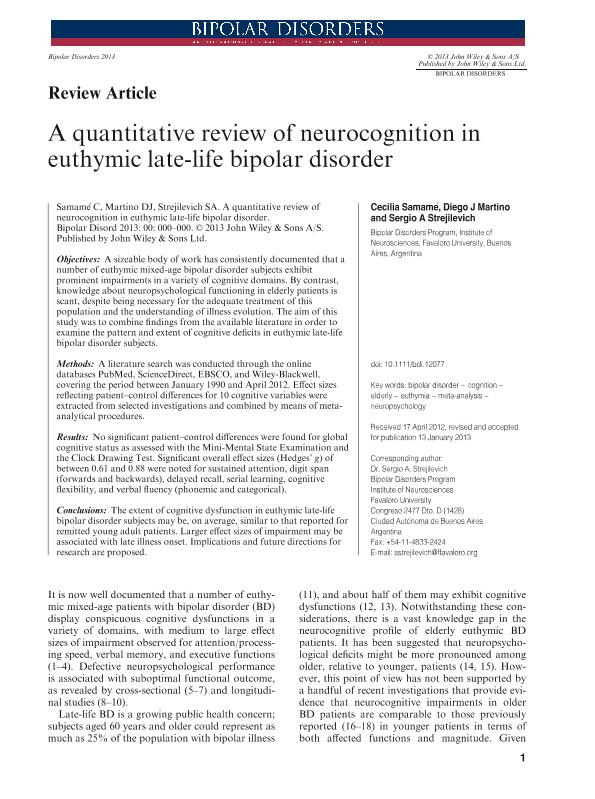Mostrar el registro sencillo del ítem
dc.contributor.author
Samame, Cecilia

dc.contributor.author
Martino, Diego Javier

dc.contributor.author
Strejilevich, S. A.

dc.date.available
2017-07-18T22:01:54Z
dc.date.issued
2013-09
dc.identifier.citation
Samame, Cecilia; Martino, Diego Javier; Strejilevich, S. A.; A quantitative review of neurocognition in euthymic late-life bipolar disorder; Wiley; Bipolar Disorders; 16; 6; 9-2013; 633-644
dc.identifier.issn
1398-5647
dc.identifier.uri
http://hdl.handle.net/11336/20915
dc.description.abstract
OBJECTIVES: A sizeable body of work has consistently documented that a number of euthymic mixed-age bipolar disorder subjects exhibit prominent impairments in a variety of cognitive domains. By contrast, knowledge about neuropsychological functioning in elderly patients is scant, despite being necessary for the adequate treatment of this population and the understanding of illness evolution. The aim of this study was to combine findings from the available literature in order to examine the pattern and extent of cognitive deficits in euthymic late-life bipolar disorder subjects. METHODS: A literature search was conducted through the online databases PubMed, ScienceDirect, EBSCO, and Wiley-Blackwell, covering the period between January 1990 and April 2012. Effect sizes reflecting patient-control differences for 10 cognitive variables were extracted from selected investigations and combined by means of meta-analytical procedures. RESULTS: No significant patient-control differences were found for global cognitive status as assessed with the Mini-Mental State Examination and the Clock Drawing Test. Significant overall effect sizes (Hedges' g) of between 0.61 and 0.88 were noted for sustained attention, digit span (forwards and backwards), delayed recall, serial learning, cognitive flexibility, and verbal fluency (phonemic and categorical). CONCLUSIONS: The extent of cognitive dysfunction in euthymic late-life bipolar disorder subjects may be, on average, similar to that reported for remitted young adult patients. Larger effect sizes of impairment may be associated with late illness onset. Implications and future directions for research are proposed.
dc.format
application/pdf
dc.language.iso
eng
dc.publisher
Wiley

dc.rights
info:eu-repo/semantics/openAccess
dc.rights.uri
https://creativecommons.org/licenses/by-nc-sa/2.5/ar/
dc.subject
Cognition
dc.subject
Elderly
dc.subject
Euthymia
dc.subject
Neuropsychology
dc.subject
Bipolar Disorder
dc.subject
Meta-Analysis
dc.subject.classification
Psiquiatría

dc.subject.classification
Medicina Clínica

dc.subject.classification
CIENCIAS MÉDICAS Y DE LA SALUD

dc.title
A quantitative review of neurocognition in euthymic late-life bipolar disorder
dc.type
info:eu-repo/semantics/article
dc.type
info:ar-repo/semantics/artículo
dc.type
info:eu-repo/semantics/publishedVersion
dc.date.updated
2017-07-18T20:05:43Z
dc.identifier.eissn
1399-5618
dc.journal.volume
16
dc.journal.number
6
dc.journal.pagination
633-644
dc.journal.pais
Estados Unidos

dc.journal.ciudad
Hoboken
dc.description.fil
Fil: Samame, Cecilia. Universidad Favaloro. Facultad de Medicina. Instituto de Neurociencias; Argentina. Consejo Nacional de Investigaciones Científicas y Técnicas; Argentina
dc.description.fil
Fil: Martino, Diego Javier. Universidad Favaloro. Facultad de Medicina. Instituto de Neurociencias; Argentina. Consejo Nacional de Investigaciones Científicas y Técnicas; Argentina
dc.description.fil
Fil: Strejilevich, S. A.. Universidad Favaloro. Facultad de Medicina. Instituto de Neurociencias; Argentina
dc.journal.title
Bipolar Disorders

dc.relation.alternativeid
info:eu-repo/semantics/altIdentifier/url/http://onlinelibrary.wiley.com/doi/10.1111/bdi.12077/abstract
dc.relation.alternativeid
info:eu-repo/semantics/altIdentifier/doi/http://dx.doi.org/10.1111/bdi.12077
Archivos asociados
